AMD Ryzen Threadripper 1950X Review
Why you can trust Tom's Hardware
Final Analysis
AMD’s mainstream Ryzen CPUs heralded the return of competition in the desktop processor market. Now, AMD brings the same Zen architecture and strategy to the high-end desktop, and we’ve already seen Intel’s reaction in the form of lower prices for its (still-pricey) Skylake-X line-up.
First, the elephant in the room: AMD positions Threadripper for creators, heavy multi-taskers, and gamers who stream to services like Twitch. It also specifically states that the processor isn’t intended for low-resolution gaming, particularly under lightly-threaded titles.
We are going to explore more intense use-cases in an upcoming feature, but were unable to complete streaming testing due to the usual time constraints we face during a launch window. We did run some ad hoc tests and were able to easily play Mafia 3 at 4K while encoding a video and running a virtual machine, which we could still access via remote desktop. We didn’t experience any significant performance degradation via our own subjective measure. Still, we prefer hard data and will work at putting definitive results behind the experience.
High-resolution gaming is unequivocally a niche, according to Steam's Hardware and Software Survey, but it's clearly growing in popularity. Of course, enthusiasts who spend $1000 on a processor are far more likely to use high-resolution monitors. But testing at 1440p or 4K very obviously pushes the bottleneck back over to the GPU. And because we're testing CPUs in these reviews, we deliberately use 1080p as a tool to emphasize broad differences between architectures and more specific deltas separating models. As GPUs evolve, higher resolutions should become more processor-bound, and hopefully by then we'll see more optimization for lots of cores.
The following gaming price efficiency charts use a geometric mean of the 99th percentile frame times (a good indicator of smoothness), which we convert into an FPS measurement and plot against price. Our suite includes six games released in 2016 and five older titles that launched in 2014/2015. Threadripper’s extra cores could enable more performance in the future as software evolves to utilize them better, so we also include a chart with newer games that exploit host processing resources more thoroughly.

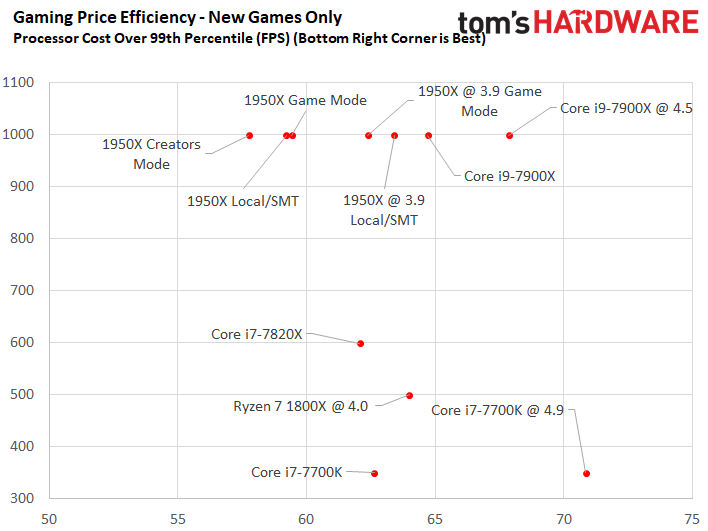
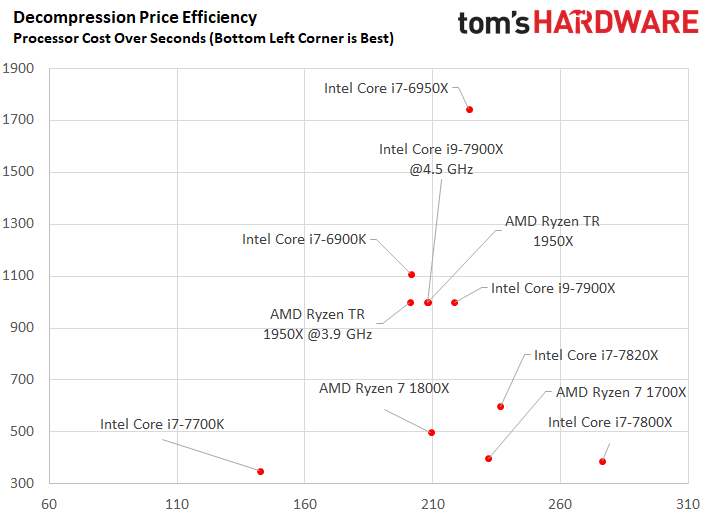
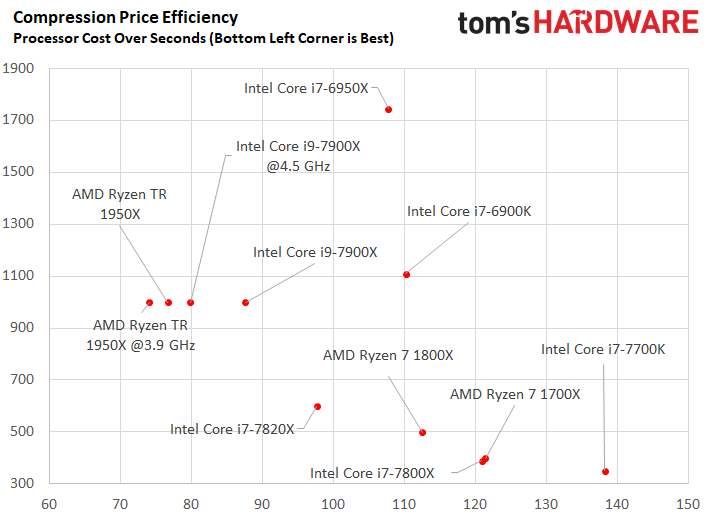
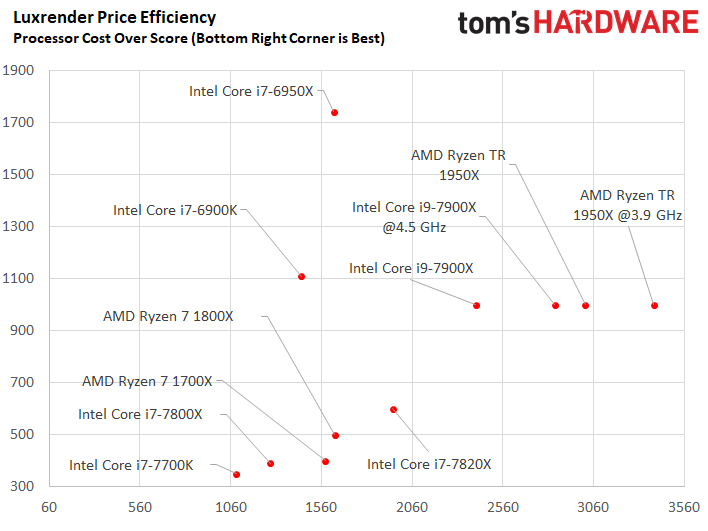
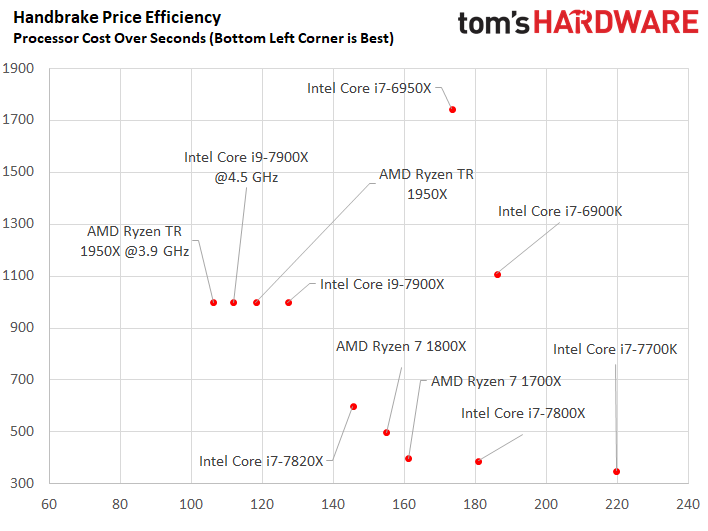

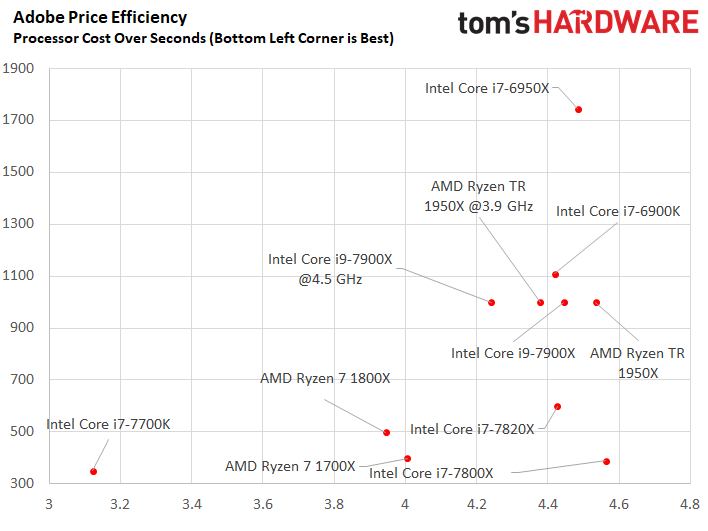
It’s clear that Intel's Core i9-7900X offers better average frame rates during purely gaming workloads, but our standard practice of focusing on 99th percentile metrics takes performance and smoothness into consideration. We’re looking at a five FPS delta between the stock -7900X and Threadripper’s best stock configuration in all games, and six FPS for new games. That gap becomes seven and four FPS, respectively, after overclocking both processors. You can imagine that gap will shrink at higher resolutions.
We didn’t add platform costs to our price efficiency charts because all high-end parts drop into obviously premium platforms, and X399 is no exception. But be mindful that you'll pay a lot more for a HEDT platform than the two mainstream configurations we tested. Cheaper alternatives like the Core i7-7700K and Ryzen 7 series are likely better for the folks who are interested in gaming, first and foremost. Much like our recommendations for Intel’s high-end desktop processors, we don’t recommend AMD’s flagship 1950X for strictly gaming, either.
Get Tom's Hardware's best news and in-depth reviews, straight to your inbox.
If your workloads are CPU-bound, though, Threadripper shines in our benchmarks written to exploit as many cores as you can throw at them. Threadripper outpaces the similarly-priced -7900X in rendering, encoding, and compression. As expected, it isn’t quite as nimble in lightly-threaded applications, such as decompression and portions of the Adobe suite. Those applications continue to favor Intel’s IPC throughput and frequency.
After the Ryzen launch, AMD was faced with the challenge of quickly maturing its motherboard ecosystem and convincing game developers to optimize existing titles for the new architecture. The company has met with success on many fronts in a relatively brief time (it’s hard to believe it’s only been five months), and enablement continues. Threadripper is a unique product that introduces even more complex challenges. No doubt, AMD is ready to take action on those, too. Case in point: Threadripper offers so many cores that some games won't even load. No doubt, Intel will face the same conundrum in the future as it scales out its architectures as well.
AMD is obviously aware of the challenges it faces. Using a combination of BIOS switches and Windows-based utilities, it exposes several knobs that ensure compatibility and address the architectural eccentricities of a data center-inspired desktop product. We’re sure to see well-heeled enthusiasts work through the settings to find the best combinations, even if most want to use Threadripper the way it ships. Of course, we like to experiment, so we’ll spend the coming weeks working on more stressful use-cases and finding the best combinations for different workloads.
Ryzen Threadripper 1950X is a solid entrant for AMD, and the company knows it's going after a niche market here. Those who need what Threadripper offers likely already know. And if that's you, we have to imagine you're elated to know there's an alternative to Intel's steep buy-in, particularly now that AMD is winning in benchmarks it hasn't won in a very long time.
MORE: Best CPUs
MORE: Intel & AMD Processor Hierarchy
MORE: All CPUs Content

Paul Alcorn is the Editor-in-Chief for Tom's Hardware US. He also writes news and reviews on CPUs, storage, and enterprise hardware.
-
I just looked at gaming benchmark and stopped reading there because as i thought Intel CPUs are killing Thread Ripper in gaming. As far as content creation, naturally having 16/32 setup will be faster than Intel 10/20 but again do you really need more than 10/20 cores. I don't and i heavily use PC for gaming, programming, web design, video/audio encoding. Overall Intel 7900x is better value and all around CPU. But if you are just in gaming 7700k is just enough.Reply
Thanks for review, and hello x299 platform.
Gaming vs. Content Creation mode through Software is just another big NO NO to me knowing how crappy AMD software is. I assume the most people will keep it in Game Mode and leave it as it is.
I appreciate that AMD brought this CPU for $999 with so many cores, helps competition but again there is nothing to drool over here in my book. AMD didn't bring any significant performance bump core vs. core basis. In fact AMD single core performance still sucks which means when Intel releases 10+ core CPU it is going to fun to watch.
Two things i am interested the most is Coffee Lake product and IPC improvement there and possible price adjustment with Core i9.
-
Kai Dowin I'm truly impressed to see 16 Zen cores consuming as much power as only 10 Skylake-X ones. Bravo, AMD!Reply -
Reply20045233 said:I'm truly impressed to see 16 Zen cores consuming as much power as only 10 Skylake-X ones. Bravo, AMD!
I am not knowing that Intel is running higher frequency.
-
JamesSneed Reply20045197 said:I just looked at gaming benchmark and stopped reading there because as i thought Intel CPUs are killing Thread Ripper in gaming. As far as content creation, naturally having 16/32 setup will be faster than Intel 10/20 but again do you really need more than 10/20 cores. I don't and i heavily use PC for gaming, programming, web design, video/audio encoding. Overall Intel 7900x is better value and all around CPU. But if you are just in gaming 7700k is just enough.
Thanks for review, and hello x299 platform.
Gaming vs. Content Creation mode through Software is just another big NO NO to me knowing how crappy AMD software is.
I love Intel even more...all you have to do pop CPU in and shit works and it works well.
I guess if gaming is why you were reading the Threadripper review then you are right it isn't as good as Intel's offerings but did you honestly expect any other result? I don't know why reviewers even do gaming tests on any CPU over 8 cores as it is mostly pointless. If you are doing scientific, encoding, professional tasks in just about every use case that is multi threaded it is blowing away every Intel offering. Of course that may change once there are 12-18 core Intel parts. However spending $1000 for a CPU is a bargain for those than can use it and never in history could you get a 16 core consumer part with this type of multi-threaded performance.
-
Lyden Thank you for this review. I was seriously considering Threadripper. Looks like the 7700k is still the sensible choice for the price when gaming.Reply -
Kai Dowin @FREAK777POWER And delivering higher multi-threaded performance with these lower clocked cores. Do you know what that's called? Efficiency.Reply -
redgarl This chip is designed for heavy calculation multithreading, it is not made for gaming, however it is working well with 1440p and 2160p.Reply
By the way, who in their mind will buy a 16 core CPU and play at 1080p with a 1080 TI... seriously, these 1080p bench are a joke and don't represent reality...
"A standard or point of reference against which things may be compared." Oxford
1080p with 1080 TI with a 16 core processor is not a point of reference at all. -
Pompompaihn Who are you people that come here and <ModEdit> about gaming performance on these chips??Reply
Threadripper is the F250 of CPUs. It's not the fastest, but it's plenty fast for 99% of your tasks, and if you need to haul a 12,000 pound trailer it'll do that, too. This is for people who do a lot of WORK on their machine but also game on the side.
<Moderator Warning: Watch your language in these forums>
